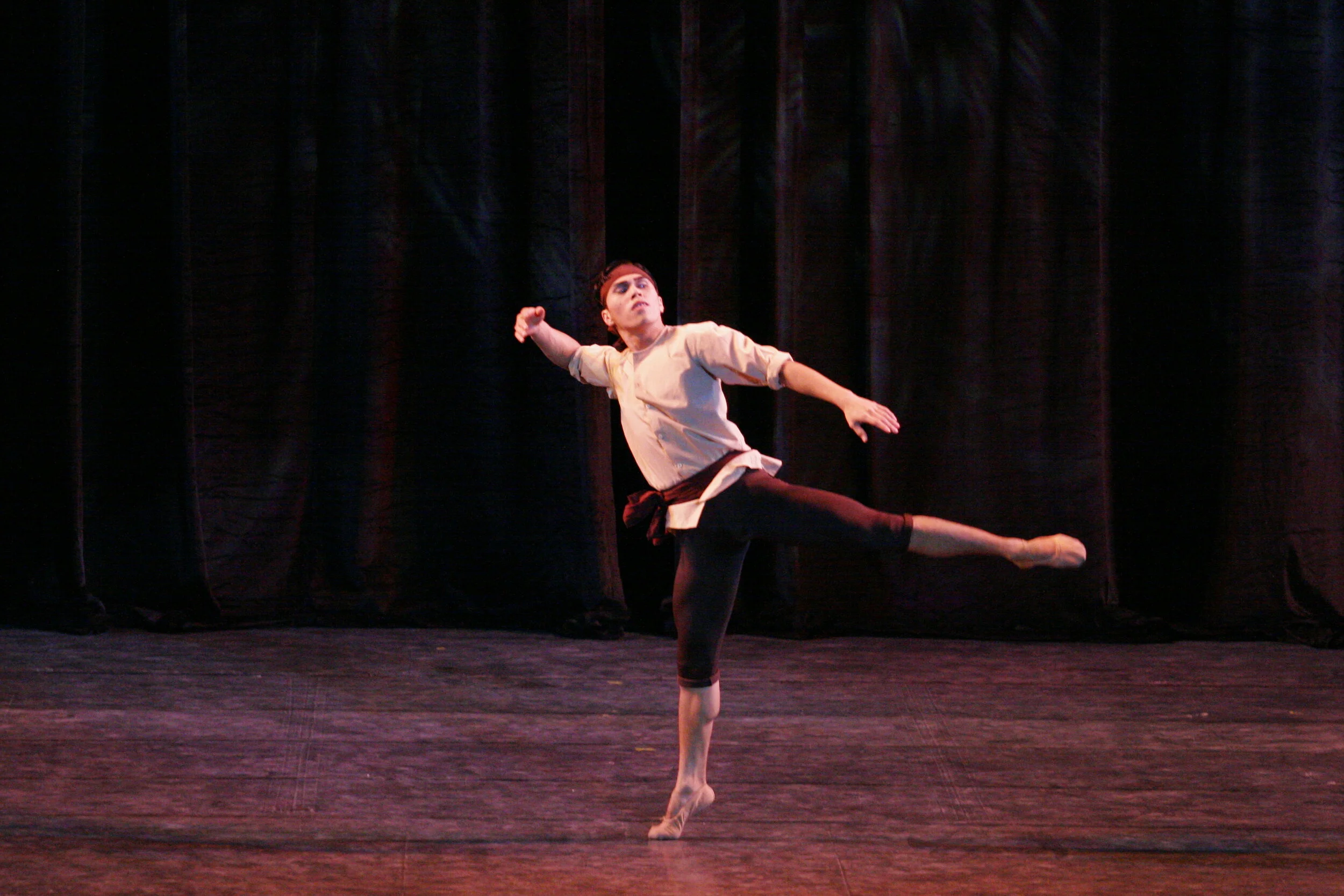Choreography in Focus: Morions by Gerardo Francisco Jr.
Morions, which made its Philippine premiere in Lab Ko ‘To (2012), is characterized by sharp and fast movements danced to intense music. Photo by Ocs Alvarez
The Lenten tradition known as the Moriones was the first thing that popped into Gerardo “Geri” Francisco Jr.’s mind when he was first told Ballet Manila was participating in the Andong Mask Festival in South Korea in 2011.
Tasked to create a new piece to be presented at the event, he instantly thought of the famed Moriones Festival in Marinduque where Catholic male devotees dress up as Roman centurions in a re-enactment of the crucifixion of Jesus Christ. Their most predominant gear, after all, is a mask complemented by helmets and armors or vests.
What indeed could be a more suitable fit for the Andong Mask Festival than a choreography based on a local tradition that also hinges on masks? “Since we are from the Philippines, we wanted something that will represent Filipino culture. This is also one of the most famous festivals in the country,” Geri points out.
The masked Roman soldiers, called Morions, would roam the streets to relate the story of the centurion Longinus who is said to have pierced the side of the crucified Jesus with a spear and was supposedly healed by the blood of Jesus.
Gerardo Francisco Jr.’s Morions is based on the Lenten tradition in Marinduque where Catholic male devotees wear masks and dress up as Roman centurions. Photo by Ocs Alvarez
As he had yet to experience the actual festival, Geri researched online and watched numerous clips of it. He was fascinated by the pageantry of the Moriones, especially seeing how people express repentance in different ways – from playing centurions to carrying a wooden cross to whipping their backs and joining a procession all over the island.
Geri soon completed Morions, a six-minute piece with six male dancers engaging in an aggressive, fast-paced showcase. He says of the music: “Malakas ang dating – intense, kumbaga, kaya nababagay siya sa piece at sa portrayal ng Roman soldiers and sa sharp and fast movements.” (It has a strong impact – you can say intense, that’s why it’s well-suited to the piece and to the portrayal of Roman soldiers and to the sharp and fast movements.)
What proved to be a challenge for the dancers, however, was wearing masks while performing. “Mahirap huminga and at the same time medyo covered ang peripheral view mo, kaya mahirap manggaya kaya dapat alam mo ang choreography and timing mo, (It’s difficult to breathe and at the same time your peripheral view is partially covered so it’s difficult to copy so you should really know the choreography and your timing),” describes Geri, who also performed in the Korean mask festival. “But eventually, you get used to it.”
He adds that the dancers have to prepare physically and mentally to take on Morions. “You have to have lots of stamina in order for you to finish this piece. If you are not prepared, uubusin niya ang energy mo.” (It will sap your energy.)
After winning the bronze medal at the Andong Mask Festival in South Korea in 2011, Morions was also performed at the 2012 Ten Drum International Festival in Taiwan. Photo courtesy of Gerardo Francisco Jr.
There was a pleasant surprise awaiting Geri and the rest of the Ballet Manila team when they arrived at the Andong Mask Festival. “It’s funny, we didn’t know it was a mask dance competition. We just found out when we arrived there. We got lucky and we even won bronze!”
The group also danced the non-competition pieces Gomburza, Reve and Agila as part of their Philippine repertoire. But it was Morions, of course, that got the most attention.
There was a sidelight to being in Morions costumes, though. Geri recalls there was a parade and street dance featuring the festival participants. What they were wearing was not exactly suited to the October climate. “Sobrang lamig sa Korea and open air ‘yung venue. Kung makita mo ang costume namin, almost walang cover ang katawan namin. (It was so cold in Korea and the venue was open-air. If you saw our costume, it was almost like our body didn’t have that much cover.) So what our tour guide did, she gave us some plastic to cover our bodies. We also filled water bottles with warm water and rolled it all over our bodies para mainitan kami (so that we would feel warm),” Geri laughs.
Another behind-the-scenes story was that they had issues with the costumes. Since the vests were made of papier mache, they would freeze in the cold weather. And the tendency was, the vests would crack every time they moved. Thus, the night before their performance, the six dancers stayed up late because they had a sudden sewing session to place garters on the costumes that kept them in place instead of cracking.
But it was well worth all the effort, as the bronze medal proved. Morions made its Philippine premiere in Lab Ko ‘To, Ballet Manila’s Valentine presentation and season-ender in February 2012.
Morions was a big hit with the audience and critic Rosalinda Orosa was all praises for it, writing: “Virile, jerky, staccato movements, intense vigor and vitality calling to mind the brisk precision of gymnasts, were utterly energizing. Indeed, how exciting and magnetic! No wonder Francisco won a bronze medal in Korea’s World Maskplay Contest!”
That year, Morions also had another enthusiastic reception at the 2012 Ten Drum International Festival in Taiwan.






